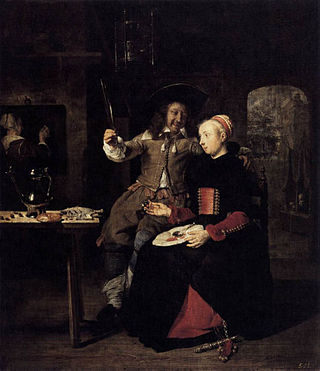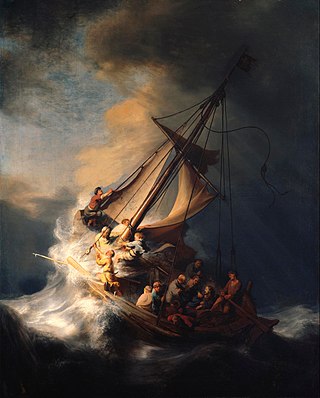
Alexis Van Hamme (12 July 1818, Brussels - 9 October 1875, Brussels) was a Belgian painter; known primarily for historical genre scenes.

Alexis Van Hamme (12 July 1818, Brussels - 9 October 1875, Brussels) was a Belgian painter; known primarily for historical genre scenes.
| | This section needs expansionwith: more personal information. You can help by adding to it. (October 2020) |
He studied at the Royal Academy of Fine Arts (Antwerp), with Nicaise De Keyser and Henri Leys; both of whom had a decisive influence on his approach to painting.
His works consist mainly of interior genre scenes, rendered in great detail. Most of them feature 17th-century settings, in the style of the old Dutch masters; especially those known as the fijnschilders. The physical details of his rooms and furnishings owe much to Gerrit Dou.
One of his more specifically historical works, "The Entry of Albert and Isabella into Brussels in 1599", was purchased by King Leopold I.
His works are still commonly featured at auctions, in Europe and the United States. They have been known to fetch prices up to €40,000 (app. 47,000 US Dollars). [1]
Most of his works are privately owned, but some may be seen at the Koninklijke Musea voor Schone Kunsten van België ("The Laceworker") [2] and the Brighton Museum and Art Gallery ("Poultry Seller"). [3] His "Dutch Market" is displayed at the New York Public Library.

Genre art is the pictorial representation in any of various media of scenes or events from everyday life, such as markets, domestic settings, interiors, parties, inn scenes, work, and street scenes. Such representations may be realistic, imagined, or romanticized by the artist. Some variations of the term genre art specify the medium or type of visual work, as in genre painting, genre prints, genre photographs, and so on.

David Teniers the Younger or David Teniers II was a Flemish Baroque painter, printmaker, draughtsman, miniaturist painter, staffage painter, copyist and art curator. He was an extremely versatile artist known for his prolific output. He was an innovator in a wide range of genres such as history painting, genre painting, landscape painting, portrait and still life. He is now best remembered as the leading Flemish genre painter of his day. Teniers is particularly known for developing the peasant genre, the tavern scene, pictures of collections and scenes with alchemists and physicians.

Willem van Mieris was an 18th-century painter from the Northern Netherlands.

Henri Leys, Hendrik Leys or Jan August Hendrik, Baron Leys was a Belgian painter and printmaker. He was a leading representative of the historical or Romantic school in Belgian art and became a pioneer of the Realist movement in Belgium. His history and genre paintings and portraits earned him a European-wide reputation and his style was influential on artists in and outside Belgium.

Gabriël Metsu (1629–1667) was a Dutch painter of history paintings, still lifes, portraits, and genre works. He was "a highly eclectic artist, who did not adhere to a consistent style, technique, or one type of subject for long periods". Only 14 of his 133 works are dated.

Dutch Golden Age painting is the painting of the Dutch Golden Age, a period in Dutch history roughly spanning the 17th century, during and after the later part of the Eighty Years' War (1568–1648) for Dutch independence.

Adriaen van Utrecht was a Flemish painter known mainly for his sumptuous banquet still lifes, game and fruit still lifes, fruit garlands, market and kitchen scenes and depictions of live poultry in farmyards. His paintings, especially the hunting and game pieces, show the influence of Frans Snyders. The two artists are considered the main inventors of the genre of the pronkstillevens, i.e. still lifes that emphasized abundance by depicting a diversity of objects, fruits, flowers and dead game, often together with living people and animals. Van Utrecht also painted a number of flower still lifes. He was a regular collaborator with leading Antwerp painters who had been pupils or assistants of Peter Paul Rubens, such as Jacob Jordaens, David Teniers the Younger, Erasmus Quellinus II, Gerard Seghers, Theodoor Rombouts, Abraham van Diepenbeeck and Thomas Willeboirts Bosschaert.

Genre painting, a form of genre art, depicts aspects of everyday life by portraying ordinary people engaged in common activities. One common definition of a genre scene is that it shows figures to whom no identity can be attached either individually or collectively, thus distinguishing it from history paintings and portraits. A work would often be considered as a genre work even if it could be shown that the artist had used a known person—a member of his family, say—as a model. In this case it would depend on whether the work was likely to have been intended by the artist to be perceived as a portrait—sometimes a subjective question. The depictions can be realistic, imagined, or romanticized by the artist. Because of their familiar and frequently sentimental subject matter, genre paintings have often proven popular with the bourgeoisie, or middle class.

Michiel Sweerts or Michael Sweerts was a Flemish painter and printmaker of the Baroque period, who is known for his allegorical and genre paintings, portraits and tronies. The artist led an itinerant life and worked in Rome, Brussels, Amsterdam, Persia and India (Goa).

Flemish Baroque painting was a style of painting in the Southern Netherlands during Spanish control in the 16th and 17th centuries. The period roughly begins when the Dutch Republic was split from the Habsburg Spain regions to the south with the Spanish recapturing of Antwerp in 1585 and goes until about 1700, when Spanish Habsburg authority ended with the death of King Charles II. Antwerp, home to the prominent artists Peter Paul Rubens, Anthony van Dyck, and Jacob Jordaens, was the artistic nexus, while other notable cities include Brussels and Ghent.

Frans Francken the Younger was a Flemish painter who created altarpieces and furniture panels and gained his reputation chiefly through his small and delicate cabinet pictures with historical, mythological or allegorical themes. He is the best-known and most prolific member of the large Francken family of artists. Francken played an important role in the development of Flemish art in the first half of the 17th century through his innovations in many genres including genre painting and his introduction of new subject matter. He was a frequent collaborator of leading Antwerp painters of his time.

Marine art or maritime art is a form of figurative art that portrays or draws its main inspiration from the sea. Maritime painting is a genre that depicts ships and the sea—a genre particularly strong from the 17th to 19th centuries. In practice the term often covers art showing shipping on rivers and estuaries, beach scenes and all art showing boats, without any rigid distinction - for practical reasons subjects that can be drawn or painted from dry land in fact feature strongly in the genre. Strictly speaking "maritime art" should always include some element of human seafaring, whereas "marine art" would also include pure seascapes with no human element, though this distinction may not be observed in practice.

Nicaise de Keyser was a Belgian painter of mainly history paintings and portraits who was one of the key figures in the Belgian Romantic-historical school of painting.

Ferdinand de Braekeleer, sometimes spelled as Ferdinand de Braeckeleer, was a Flemish painter and printmaker. He is known for his paintings of genre scenes, church interiors, historic events, religious scenes, cityscapes, market scenes and market still lifes. He is called 'the Elder' to distinguish him from his son with the same name, who was also a painter.

Jozef Geirnaert, also known as Jozef Lodewijk Geirnaert, Théodore-Joseph-Louis Geirnaert and Joseph Louis Geirnaert, was a 19th-century painter and draughtsman from Belgium. He is known for his genre scenes, portraits as well as his historical, religious and mythological paintings. He was first influenced by the Neoclassical style of Jacques-Louis David and later by the version of Romanticism that was in vogue in Belgium from the 1830s.

Petrus van Schendel (1806-1870) was a Dutch-Belgian genre painter in the Romantic style who specialized in nighttime scenes, lit by lamps or candles. This led to him being known as "Monsieur Chandelle".

Henri, Hendrik, or Henry Voordecker was a Belgian painter of genre scenes, especially of birds such as pigeons – his most notable works include Hunter's Home. By late in his career he was regarded as perhaps the most distinguished painter in Brussels, and was also successful in Britain.

Joseph Lies or Joseph Henri Hubert Lies was a Belgian Romantic painter, draughtsman and engraver. He worked in a wide range of genres including history painting, landscapes, genre scenes and portraits. He enjoyed a European-wide reputation during his lifetime.

Jan Peeter Verdussen or Jan Pieter Verdussen was a Flemish painter, draftsman and printmaker. He is known mainly for his battle scenes, incidents of camp life and equestrian paintings. He also painted landscapes with hunting scenes, gallant companies and genre scenes of markets.

Ernest Slingeneyer, Ernest Isidore Hubert Slingeneyer or Ernst Slingeneyer was a Belgian painter of history paintings, portraits, genre scenes and the occasional landscape. Slingeneyer is regarded as one of the last representatives of Romanticism in Belgian painting and of Academism in Romanticism in Belgian art. In his later career he was one of the leading representatives of Orientalism in Belgium. An excellent portraitist, Slingeneyer made portraits of historical figures as well as of well-known figures from his time. Slingeneyer was also a politician and was a member of the Belgian Chamber of Representatives for the Independists of Brussels, a coalition of personalities bound by their opposition to the Radicalist liberals. As a politician he promoted Academic art and agitated against new artistic currents as promoted by, amongst others, the Société Libre des Beaux-Arts in Brussels.